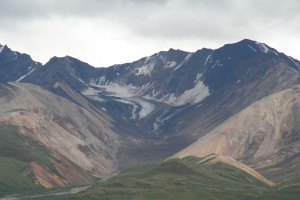16 December 2010
A Climate Carol: Scientists as the Spirits of Climates Past
Posted by mohi

Warming global temperatures have led to the retreat of glaciers, such as this one in Denali National Park, Alaska. To better understand the future of climate and of these retreating glaciers, scientists study climate change in the past. Photo courtesy of Dennis G. Dye, USGS
Although people may not feel particularly overheated after this week’s Midwestern snowstorm, data from NASA show that the 12-month period from November 2009 to November 2010 was the warmest on record since 1880. Glaciers worldwide are retreating, and studies are beginning to forecast the likelihood of specific glaciers disappearing entirely. The continued warming trend leads naturally to the question, “Just how hot is it going to get?” Coming up with an answer is no easy task.
One way to predict the future is to first look back in time. During session PP31D, Reconstruction and Modeling of Global Climate Evolution of the Past 21,000 Years I, scientists played the role of the Spirit of Climates Past.
Whisking listeners back thousands of years, Jeremy Shakun, of Oregon State University, presented results from an analysis of approximately 80 proxy temperature data sets (proxy because thermometers had not yet been invented 21,000 years ago) that spanned the globe. These records of temperature are inferred from analyses of tree-rings, ice cores, and corals based on chemical signatures in layers formed long ago. Shakun’s team found that atmospheric carbon dioxide fluctuations coupled with how North Pole warming is linked to South Pole cooling (and vice versa) could account for much of the global temperature change over the past 21,000 years.
Adding detailed notes to the screenplay of past climates, W. Richard Peltier, of the University of Toronto, examined only the Younger Dryas (Y-D) temperature shift. This shift, which occurred between 12,900 to 11,500 years ago, was a period of sudden cooling in the Northern Hemisphere, a stark reversal of a preceding warming trend. Peltier presented a new model that describes how the Y-D shift may have been triggered by a sudden high outflow of meltwater from continental glaciers into the Arctic Ocean. This influx of fresh water may have shut down oceanic circulation, which then caused climate to cool when warmer waters ceased to bathe northern shores.
Other talks during the session introduced us to additional actors in climate history. Peat bogs store carbon, sucking it out of the atmosphere and stashing it underground. Oceans play a similar role, capturing or releasing carbon depending on climate conditions.
A key theme throughout the talks was the marriage of data and modeling. A model is only useful if it can be trusted to make accurate predictions. Extensive climate data helps scientists test and refine their climate models.
Here’s hoping for the continued cooperation of climate data gatherers and climate model programmers. After refining predictive tools, the Spirit of Climates Future may show policy makers an even clearer vision of what lies ahead, should carbon dioxide levels continue to rise.
–Catherine Meyers is a science communication graduate student at UC Santa Cruz


 GeoSpace is a blog on Earth and space science, managed by AGU’s Public Information staff. The blog features posts by AGU writers and guest contributors on all sorts of relevant science topics, but with a focus on new research and geo and space sciences-related stories that are currently in the news.
GeoSpace is a blog on Earth and space science, managed by AGU’s Public Information staff. The blog features posts by AGU writers and guest contributors on all sorts of relevant science topics, but with a focus on new research and geo and space sciences-related stories that are currently in the news.